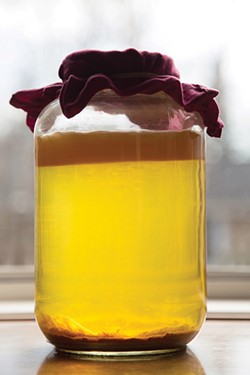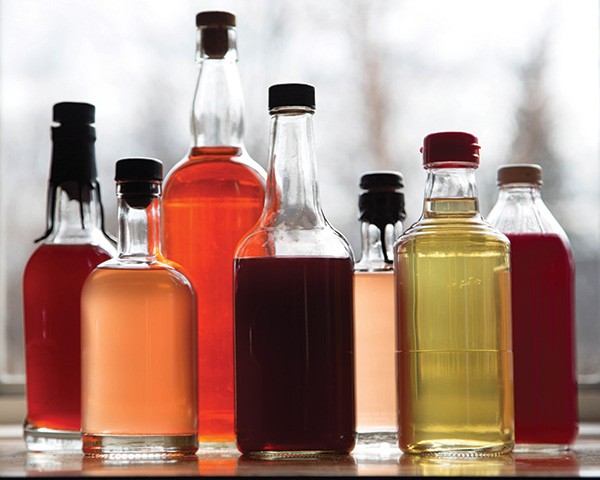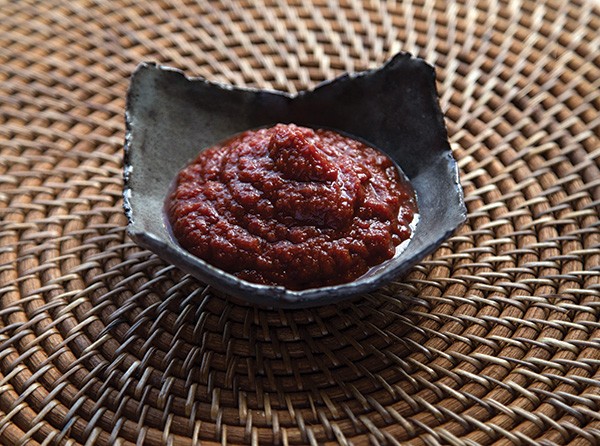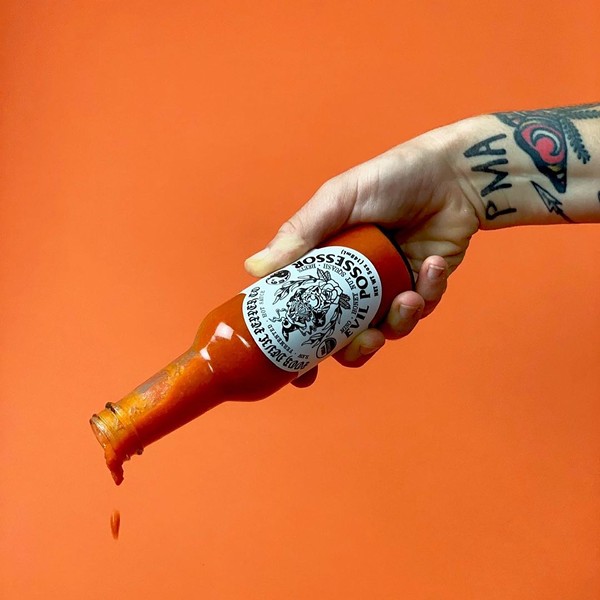A few years ago, I profiled Brother Victor-Antoine d'Avila-Latourrette, a Benedictine monk who makes the best vinegars I've ever tasted. Pursuant to that visit, and several others since, I have become somewhat of a vinegar-making addict; my kitchen counter currently boasts 10 half-gallon jars with various versions in different states of ferment. Vinegar is hands down the easiest of all homemade products, and though it takes a while—six to 12 months if you do it right—the results will excite and enliven your cooking practice as much as anything else you make. To wit: Virtually all of the standard condiments (ketchup, mustard, mayonnaise, barbecue sauce) that you currently pay for can be made better at home, and having custom vinegars on hand is a key first step.

Not Far From the Tree
We live in one of the world's great apple regions. To not take advantage, specifically in the form of homemade cider vinegar, is an affront to your geographical privilege. Apple juice, left to its own devices, becomes vinegar. Yeast and acetic acid bacteria are omnipresent; they're all over your kitchen right now. All you have to do is let them do their thing. Their thing, it turns out, is a nifty one-two punch that makes sweet juice into sour vinegar: Yeast ferments the sugar into alcohol, and then acetobacteria ferment that into vinegar. If you can get unpasteurized cider, pour it into a glass jar (cover it with cheesecloth to keep the flies out) and leave it somewhere at room temperature for six months. If you can't get unpasteurized juice, be sure to add a generous glug of the raw cider vinegar "with the mother," available at health food stores.
Every fall, I pick sumac panicles and blend them with cider, letting them steep overnight, then strain the result and inoculate it with mother; the result is beautiful pink liquid that has lovely blood orange-type flavors. I also use black currant juice from Connecticut to make brilliant violet vinegar that's pure joy and very drinkable on its own (diluted, of course). Wine—red and white—also ferments alongside jars of spruce tips that I pick in May, steep in vodka, then dilute with white wine and inoculate with mother. All of these make for glorious and very local substitutes for citrus in cooking and even cocktails. It's worth remembering that kombucha and vinegar are two points on the same continuum of fermentation; if you make your own kombucha and let it sit a few months longer, you've got vinegar. And once you've got vinegar, you hold the key to condiment independence.
Mayo Clinic
Many people are intimidated by the thought of making mayonnaise. I understand; if done improperly, it can break, and that only needs to happen once in order for the shame of failure to attend any subsequent urges in that direction. Most mayonnaises break because there's not enough water for the egg yolk to form a stable emulsion with the copious oil you're pouring in. I usually use vinegar; lemon is obviously a popular choice, but it's not a local flavor. If you want an extra-mild version, use a couple tablespoons of water, but acidity makes it better, and safer (given the raw egg yolk). Whatever the form, that extra splash of moisture means that all those fat molecules you're about to add have enough dance partners to emulsify and thicken your mayo to a redoubtable stiffness. Besides vinegar, pickle brines or hot sauces can also be used to great effect.
Mustard contains lecithin, a powerful emulsifier, so a teaspoon or so helps a lot. Garlic is always good, and also helps emulsify; roasted garlic is magnificent, as are fresh herbs. I use the food processor, but a blender works, if noisily, and you can whisk by hand as well. Add the oil in a spaghetti-thin stream, especially at the outset. I like olive oil; it's good for you and has a wonderful flavor. Shitty oil makes shitty mayonnaise. A cup of oil per yolk is a good ratio. Depending on its intended use, it's fun to tweak your oil mixture a bit: a bit of sesame, or mustard, or walnut, or pumpkin seed oil can tilt the flavor any which way. Mixtures are nice: A base of olive, for example, with some rendered bacon fat mixed in is not the worst combination in the world.
I put an egg yolk, a spoon of mustard, a glug of vinegar, a fat pinch of salt, and a twist of pepper in the bowl of the food processor, along with any other custom flavorings like preserved lemon, grated garlic, herbs, spices, hot peppers, or the like. The key is in that vinegar or citrus juice. If you're nervous, add a tablespoon or two more of water to be sure. Measure out a cup of oil(s) into a pitcher with a spout. Then start the motor, dribbling the oil in super gently—spaghetti-thin, remember—until you see the viscosity change and thicken. The liquid will become more of a goop, and begin lapping at the sides of the vessel. At this point you can increase the flow rate of the oil if you like. Once the oil is gone, stop the blade, open it up, and spatulate the mayo thoroughly to get at the layer of oil that will be hiding under your blade. Then pulse it a few more times to fully incorporate it. And you're done. Be happy; you just mastered one of the most vivid examples of how much better homemade food is than store bought. Now every manner of dip, tartar sauce, Russian dressing, and glorious sandwich is within your reach.

Cut the Mustard
Making mustard is as simple as obtaining mustard seeds, whole or ground, or both, and adding vinegar, salt, and any other flavors you might desire. Use equal volumes of mustard seeds (white are milder than brown), vinegar, or wine (or substitute water for wine). Let it sit for a couple of days and then blend it as smooth as you like. Reserve some whole soaked seeds and add them at the end for a country-style look. If you want it extra-hot use some powdered mustard as well and adjust the moisture accordingly. Add some turmeric if you like it yellow. Horseradish is grand too. Honey, garlic, herb pestos, fresh fruit, booze—there's no limit to the tweaks you can make, especially when you begin with flavored vinegar.
With Natural Mellowing Agents
If you can tomatoes every fall, you're already halfway to ketchup. Purée the tomatoes, add a sweetener (honey or maple syrup to keep it local) and a few flavors, and you're in business. Ketchup originated in Malaysia, via China—Kecap Manis is a sweet Malaysian soy sauce—where it often includes fermented fish sauce. Adding fish sauce, or Worcestershire, or even just a few anchovies, makes a big, umami-boosting difference to the result. Try this: For every quart of purée, add about a cup of chopped onion, a couple cloves of garlic, a cup of brown sugar or maple syrup, a cup of vinegar, a couple big spoons of mustard, a few dashes of fish sauce, a teaspoon each of salt and pepper, a half teaspoon of ground allspice, and a few cloves. Cook it all for a few hours, low and slow, checking for thickness, then blend it smooth and put it in a jar or bottle in the fridge when it's cool. A little molasses can also be a great addition, as can some tamarind paste.
Then taste it again. Good? Needs something? Tinker with it. For extra credit, add a few spoonfuls of yogurt whey—you already make yogurt of course—and let it ferment for a few days at room temperature (top it with a bit more whey to protect it from the air). Voilà! Lacto-fermented ketchup that's miles better than anything in the store. Try adding a little cinnamon, or ginger, or curry powder. Try roasted peppers, or smoked ones, hot or sweet. A little saffron might amaze you. Try a basic version, then mess with it depending on what you're using it for; saffron and roasted peppers will give it a Spanish slant. Ginger, hot peppers, and extra fish sauce (plus some soy) will tilt it back toward its Asian roots.
If you make a roasted-garlic-saffron-sherry-vinegar aioli, then blend that with smoked red pepper ketchup, you've got an insanely great Spanish-tinged Russian dressing (if that makes sense) for seafood, roast pork sandwiches, or tossing with roasted potatoes. Use preserved lemon and cumin in the mayo and harissa in the ketchup and you're on your way to the best lamb sandwich or falafel you've ever eaten. Take your ketchup, increase the sweet, the vinegar, and the spice, and you're getting into barbecue sauce territory. I like to use tamarind paste, soy sauce, and coffee in mine, as well as plenty of mustard. There are worse ways to spend a warm afternoon than tinkering with your sauce mixture, using the thinner early state to mop whatever's smoking on the grill as the rest reduces to a dark, sticky irresistibility.
Take Control
Space does not permit exhaustive recipes here, and they're beside the point. The goal is to inspire you to take control of your ingredients farther up the supply chain than you currently do. It's the key to great cooking; when you can cant a condiment toward a particular profile, you can customize the flavors in your food to the fullest possible extent and feature local produce at every level. Beyond the frugality and DIY satisfaction, making your own condiments helps you realize how everything we think of as fixed is actually mutable, subject to our own tastes and preferences and the ingredients we have on hand. People pay serious money for clothes that are tailor made, but you can get bespoke food for next to nothing.














